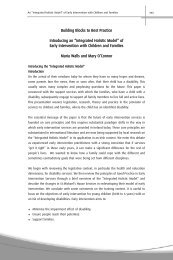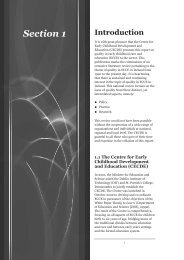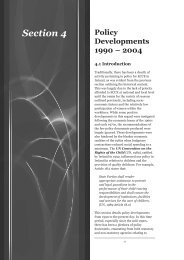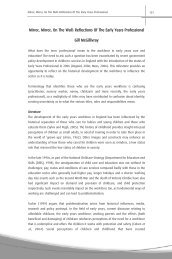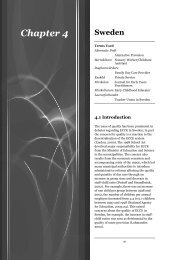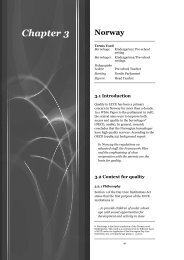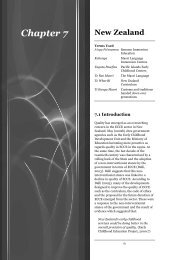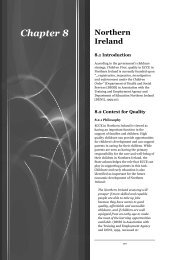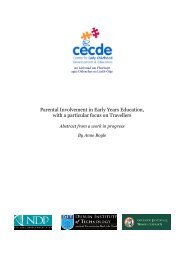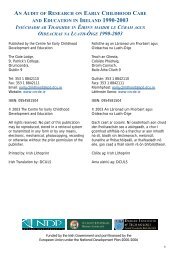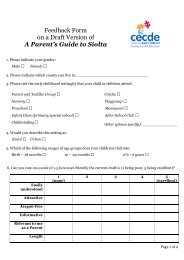Bibliography - Centre for Early Childhood Development & Education
Bibliography - Centre for Early Childhood Development & Education
Bibliography - Centre for Early Childhood Development & Education
Create successful ePaper yourself
Turn your PDF publications into a flip-book with our unique Google optimized e-Paper software.
<strong>Bibliography</strong>Abbott, L. and Pugh, G. (1998) (Eds.).Training to Work in <strong>Early</strong> Years.Buckingham: Open University Press.Adams L. and Hanley P. (2000). <strong>Early</strong><strong>Childhood</strong> <strong>Education</strong> <strong>for</strong> Children withDisabilities in New Zealand” (in) DisabilityWorld – A Bimonthly Web-zine ofInternational Disability News and Views.Issue no. 2, Accessed at: http//www.disabilityworld.org/April-May2000/Children/NewZealand.htm, 15 th July,2004.Alcock, S. (1996). Fellowship ReportQuality Systems in <strong>Early</strong> <strong>Childhood</strong><strong>Centre</strong>s. Margaret May Blackwell TravelStudy Fellowship, Accessed at: http://www.ecdu.govt.nz/publications/research/SophieAlcock.doc, 15 th July, 2004.Alvestad, M. and Samuelsson, I. (1999). AComparison of the National PreschoolCurriculum in Norway and Sweden. <strong>Early</strong><strong>Childhood</strong> Research and Practice, Volume1, No. 2, Accessed at: http://ecrp.uiuc.edu/v1n2/print/alvestad.html, August 10 th ,2004.Area <strong>Development</strong> Management (2003a).EOCP Quality Sub-Measure NVCOPriorities and Range of Actions <strong>for</strong>possible Future Funding (2004-2006)Discussion and Guidance Paper. Dublin:Area <strong>Development</strong> Management.Area <strong>Development</strong> Management (2003b).Strategic Plan. Dublin: Area <strong>Development</strong>Management.Area <strong>Development</strong> Management (2003c).National Childcare Census Baseline Data1999-2000. Dublin: Area <strong>Development</strong>Management.Arnett, J. (1989). “Caregivers in Day-careCenters: Does Training Matter?” Journal of113
<strong>Bibliography</strong>Applied <strong>Development</strong>al Psychology,Volume 10, pp. 541-552.Ball, C. (1994). Start Right: TheImportance of <strong>Early</strong> Learning. London:Royal Society <strong>for</strong> the Encouragement ofArts, Manufacture and Commerce.Barnett, W. (1995). “Long-Term Effects of<strong>Early</strong> <strong>Childhood</strong> Programs on Cognitiveand School Outcomes” (in) The Future ofChildren. Accessed athttp://www.futureofchildren.org/pubsinfo2825/pubs-info.htm?doc_id=77657,15 th October, 2004.Bennett, J. (2000). “Goals, Curricula andQuality Monitoring in <strong>Early</strong> <strong>Education</strong>Systems.” Paper produced <strong>for</strong> ConsultativeMeeting on International <strong>Development</strong>s inECCE.Bertram, T. and Pascal, C. (2002). <strong>Early</strong>Years <strong>Education</strong>: An InternationalPerspective. London: Qualifications andCurriculum Authority. Accessed at:http://www.inca.org.uk, 9 th August, 2004.Blau, D. (1997). “The Production of Qualityin Child Care <strong>Centre</strong>s” (in) The Journal ofHuman Resources Volume 32, No. 2, pp.354-387.Blenkin, G., Rose, J. and Yue, N. (1996).“Government Policies and <strong>Early</strong> <strong>Education</strong>:Perspectives from Practitioners” (in)European <strong>Early</strong> <strong>Childhood</strong> ResearchJournal. Volume 4, No. 2, pp. 5–19.Bloch, M. (1992). “Critical Perspectives onthe Historical Relationship between Child<strong>Development</strong> and <strong>Early</strong> <strong>Childhood</strong><strong>Education</strong> Research” (in) Kessler, S. andSwadener, B. (Eds.) Reconceptualizing the<strong>Early</strong> <strong>Childhood</strong> Curriculum: Beginningthe Dialogue. New York: Teachers’ CollegePress.Border Counties Childcare Network (2004).Newsletter – March 2004. Issue 13.Border Counties Childcare Network,Accessed at: http://www.bccn.ie/leafbccn.htm, 1 st July, 2004.Bowman, B., Donovan, M. and Burns, M.(Eds.) (2001). Eager to Learn: Educatingour Preschoolers. Washington DC:National Academic Press.Burchinal, M. (1999). “Child CareExperiences and <strong>Development</strong>al Outcomes”(in) Helburn, S. (Ed.). The Silent Crisis inU.S. Child Care [Special Issue]. Annals ofthe American Academy of Political andSocial Science, Volume 563, pp. 73-97.Burgard, R. (2000). “The FrankfurtKindergartens” (in) Penn, H. (Ed). <strong>Early</strong><strong>Childhood</strong> Services Theory, Policy andPractice. Buckingham: Open UniversityPress.Cameron, C., Candappa, M., McQuail, S.,Mooney, A., Moss, P. and Petrie, P. (2003).<strong>Early</strong> Years and Childcare InternationalEvidence Project: The Work<strong>for</strong>ce. London:DfES.Candappa, M., Moss, P., Cameron, C.,McQuail, S., Mooney, A. and Petrie, P.(2003). <strong>Early</strong> Years and ChildcareInternational Evidence Project: Fundingand Sustainability. London: DfES.Carr. M. (1998a). Assessing Children’sLearning in <strong>Early</strong> <strong>Childhood</strong> Settings: AProfessional <strong>Development</strong> Programme <strong>for</strong>Discussion and Reflection (Three Videosand Workshop Programme). Wellington:New Zealand Council For <strong>Education</strong>alResearchCarr, M. (1998b). “A Project <strong>for</strong> AssessingChildren’s Experiences in <strong>Early</strong> <strong>Childhood</strong>Settings” (in) Learning and TeachingStories New Approaches to Assessmentand Evaluation in relation to Te Whariki.Symposium <strong>for</strong> 8 th European Conferenceon Quality in <strong>Early</strong> <strong>Childhood</strong> Settings,Santiago de Compostela, Spain, September1998.114
<strong>Bibliography</strong>Carr M. and May, H. (1998). “Introduction- An update of Te Whariki The NewZealand National <strong>Early</strong> <strong>Childhood</strong>Curriculum” (in) Learning and TeachingStories: New Approaches to Assessmentand Evaluation in relation to Te Whariki.Symposium <strong>for</strong> 8 th European Conferenceon Quality in <strong>Early</strong> <strong>Childhood</strong> Settings,Santiago de Compostela, Spain, September1998.Carr M. and May, H. (2000). “Te Whariki:Curriculum Voices” (in) Penn, H. (Ed.).<strong>Early</strong> <strong>Childhood</strong> Services - Theory Policyand Practice. Buckingham: OpenUniversity Press.Carr, M., May, H. and Podmore, V. (2000).Learning and Teaching Stories: ActionResearch on Evaluation in <strong>Early</strong><strong>Childhood</strong>. Final Report to the Ministry of<strong>Education</strong>. Wellington: NZCER.Carroll, E. in collaboration with O’Dwyer,L. (2002). The Well-Being of Children.Four Papers Exploring Conceptual, Ethicaland Measurement Issues. Dublin: IrishYouth Foundation.Caughy, M., Di Pietro, J. and Strobino, M.(1994). “Day-care Participation as aProtective Factor in the Cognitive<strong>Development</strong> of Low-income Children” (in)Child <strong>Development</strong>. Volume 65, pp.457–71.<strong>Centre</strong> <strong>for</strong> <strong>Early</strong> <strong>Childhood</strong> <strong>Development</strong>and <strong>Education</strong> (2001). Programme ofWork. Accessed at: http://www.cecde.ie/english/pdf/work_programme.pdf, 15 thOctober, 2004.<strong>Centre</strong> <strong>for</strong> <strong>Early</strong> <strong>Childhood</strong> <strong>Development</strong>and <strong>Education</strong> (2003). An Audit ofResearch on <strong>Early</strong> <strong>Childhood</strong> Care and<strong>Education</strong> in Ireland 1990 - 2003. Dublin:<strong>Centre</strong> <strong>for</strong> <strong>Early</strong> <strong>Childhood</strong> <strong>Development</strong>and <strong>Education</strong><strong>Centre</strong> <strong>for</strong> <strong>Early</strong> <strong>Childhood</strong> <strong>Development</strong>and <strong>Education</strong> (2004a). Talking AboutQuality – Report of a Consultation Processon Quality in <strong>Early</strong> <strong>Childhood</strong> Care and<strong>Education</strong>. Dublin: <strong>Centre</strong> <strong>for</strong> <strong>Early</strong><strong>Childhood</strong> <strong>Development</strong> and <strong>Education</strong>.<strong>Centre</strong> <strong>for</strong> <strong>Early</strong> <strong>Childhood</strong> <strong>Development</strong>and <strong>Education</strong> (2004b). Research Strategy.A Work in Progress. Accessed at: http://www.cecde.ie/english/pdf/research_strategy.pdf, 15 th October, 2004.<strong>Centre</strong> <strong>for</strong> Migration and <strong>Development</strong>Working Paper Series Princeton University.Accessed at: http://cmd.princeton.edu/papers/wp0309b.pdf, 15 th October, 2004.Child Care Aware (2001). Choosing ChildCare <strong>for</strong> a Child with Special Needs.National Association of Child CareResource and Referral Agencies and EasterSeals, Accessed at: http://www.childcareaware.org/en/tools/pubs/pdf/102e.pdf, 16 th July, 2004.Childcare Resource and Research Unit(1997). What does Research tell us aboutQuality in Child Care? University ofToronto: CRRU Factsheet.Children Order Regulations and Guidance(1996). Volume 2 Family Support,Childminding and Day Care. Accessed at:http://www.nics.gov.uk/ni-direct/dhss/child/volume2.pdf, 15 th March, 2004.Children’s Services Northern Ireland,Accessed at: http://www.google.ie/search?q=cache:iyL7DHSVkc8J:www.childrensservicesnorthernireland.com/earlyyears/faq.asp+Social+Services+<strong>Early</strong>+Years+Teams+assessment+premises+staff&hl=en&start=1,15 th October, 2004.Choi, S. (2003). Lifelong Learning andSocial Policy <strong>for</strong> <strong>Early</strong> <strong>Childhood</strong>.UNESCO Policy Briefs on <strong>Early</strong> <strong>Childhood</strong>.Accessed at: http://www.unesco.org/education/educprog/ecf/pdf/brief11en.pdf,1 st July, 2004.115
<strong>Bibliography</strong>Clark, A. and Moss, P. (2001).Listening to Young Children -TheMosaic Approach. London: NationalChildren’s Bureau.Clearinghouse (2003a). New Zealand. TheClearinghouse on International<strong>Development</strong>s in Child, Youth and FamilyPolicies at Colombia University. Accessedat: www.childpolicyintl.org/countries/newzealand.html, October 15 th , 2004.Clearinghouse (2003b). Norway. TheClearinghouse on International<strong>Development</strong>s in Child, Youth and FamilyPolicies at Colombia University. Accessedat: http://www.childpolicyintl.org/,October 15 th , 2004.Clearinghouse (2003c). Portugal. TheClearinghouse on International<strong>Development</strong>s in Child, Youth and FamilyPolicies at Colombia University. Accessedat: http://www.childpolicyintl.org/countries, October 15 th , 2004.Cleary, A., Nic Ghiolla Phádraig, M. andQuin, S. (2001) (Eds.). “Introduction” (in)Understanding Children, Volume 1: State,<strong>Education</strong> and Economy. Cork: Cork TreePress.Coolahan, J. (Ed.) (1998). Report on theNational Forum <strong>for</strong> <strong>Early</strong> <strong>Childhood</strong><strong>Education</strong>. Dublin: The Stationery Office.Council <strong>for</strong> Curriculum, Examinations andAssessment (1997). Curricular Guidance<strong>for</strong> Pre-school <strong>Education</strong>. Belfast: DENI.Cryer, D., Tietze, W. and Wessels, H.(2002). “Parents’ Perceptions of theirChildren’s Child Care: A CrossnationalComparison” (in) <strong>Early</strong><strong>Childhood</strong> Research QuarterlyVolume 17, No. 2, pp. 259-277.Cryer, D., Tietze, W., Burchinal, M., Leal, T.and Palcios, J. (1999). “Predicting ProcessQuality from Structural Quality inPreschool Programs: A Cross-countryComparison” (in) <strong>Early</strong> <strong>Childhood</strong>Research Quarterly, Volume 14, No. 3, pp.339-361.Cubey, P. and Dalli, C. (1996). QualityEvaluation of <strong>Early</strong> <strong>Childhood</strong>Programmes: A Literature Review.Occasional Paper Series. Wellington:Institute <strong>for</strong> <strong>Early</strong> <strong>Childhood</strong> Studies,Victoria University of Wellington.Cullen, J. (1996). “The Challenge of TeWhãriki <strong>for</strong> Future <strong>Development</strong> in <strong>Early</strong><strong>Childhood</strong> <strong>Education</strong>” (in) Delta, Volume48, No. 1, pp. 113-25.Curtis, A. (2000). Indicators of Quality in<strong>Early</strong> <strong>Childhood</strong> <strong>Education</strong> and CareProgrammes. Accessed at:http://www.worldbank.org/children/nino/basico/Curtis.htm, October 15 th ,2004.Dahlberg, G. (2000). “Everything is aBeginning and Everything is Dangerous:Some Reflections on the Reggio EmiliaExperience” (in) Penn, H. (Ed.). <strong>Early</strong><strong>Childhood</strong> Services Theory, Policy andPractice. Buckingham: Open UniversityPress.Dahlberg, G., Moss, P. and Pence, A.(1999). Beyond Quality in <strong>Early</strong> <strong>Childhood</strong><strong>Education</strong> and Care. Post-modernPerspectives. London: Falmer Press.Dalli, C. (2003). <strong>Early</strong> <strong>Childhood</strong> Policy inNew Zealand: Stories of SectorCollaborative Action in the 1990’s.<strong>Education</strong> International Working PapersNo. 10. Brussels: <strong>Education</strong> International.Daycare Trust (1998). Listening toChildren. Young children’s Views onChildcare: A Guide <strong>for</strong> Parents. London:Daycare Trust.Depree, L. and Hayward, K. (2001).Creating Changes to Culture. Using theQuality Journey Resource as a ReflectiveTool. Paper presented at the New Zealand116
<strong>Bibliography</strong>Association <strong>for</strong> Research in <strong>Education</strong>Annual Conference, December, Dunedin.Department of <strong>Education</strong> Northern Ireland(2002). Begin with Quality - The PreschoolExpansion Programme. Quality of<strong>Education</strong>al Provision in Voluntary andPrivate Pre-school <strong>Centre</strong>s September 1998– June 2001. Accessed at: http://www.deni.gov.uk/inspection_services/general_pub/V%20and%20P%20Pre%20School%20<strong>Centre</strong>s.pdf, 19 th July, 2004.Department of <strong>Education</strong> and Science(1998). <strong>Education</strong> Act. Dublin: TheStationery Office.Department of <strong>Education</strong> and Science(1999). Ready to Learn - White Paper on<strong>Early</strong> <strong>Childhood</strong> <strong>Education</strong>. Dublin: TheStationary Office.Department of <strong>Education</strong> and Science(2000). <strong>Education</strong> Welfare Act. Dublin:The Stationery Office.Department of Health (1996). The ChildCare (Pre-school Services) Regulations.Dublin: The Stationary Office.Department of Health and Children(2000). National Children’s Strategy: OurChildren - Their Lives. Dublin: TheStationary Office.Department of Justice, Equality and LawRe<strong>for</strong>m (1998). Study of the Economics ofChildcare in Ireland. Dublin: TheStationery Office.Department of Justice, Equality and LawRe<strong>for</strong>m (1999). National ChildcareStrategy: Report of the Partnership 2000Expert Working Group on Childcare.Dublin: The Stationary Office.Department of Justice, Equality and LawRe<strong>for</strong>m (2002). Model Framework <strong>for</strong><strong>Education</strong>, Training and Professional<strong>Development</strong> in the <strong>Early</strong> <strong>Childhood</strong> Careand <strong>Education</strong> Sector. Dublin: Departmentof Justice, Equality and Law Re<strong>for</strong>m.Department of Justice, Equality and LawRe<strong>for</strong>m (2004). Developing Childcare inIreland – A Review of Progress to End2003 on the Implementation of the EOCP2000-2006. Dublin: Department of Justice,Equality and Law Re<strong>for</strong>m.Department of Justice, Equality and LawRe<strong>for</strong>m, Accessed at: http://www.justice.ie/80256996005F3617/vWeb/wpJWOD4TFJHN, 1st July, 2004.DHSS and DENI (1997). CurricularGuidance <strong>for</strong> Pre-school <strong>Education</strong>.Belfast: Northern Ireland Council <strong>for</strong>Curriculum, Examinations and Assessment.DHSS in Association with the Training andEmployment Agency and DENI (1999).Children First - The Northern IrelandChildcare Strategy. Accessed at: http://www.dhsspsni.gov.uk/publications/archived/childfirst.asp, July 21 st , 2004.Doherty-Derkowski, G. (1994).Quality Matters: Excellence in <strong>Early</strong><strong>Childhood</strong> Programs. Don Mills,Ontario: Addison-Wesley PublishersLimited.<strong>Early</strong> <strong>Childhood</strong> <strong>Development</strong>,Accessed at: http://www.ecd.govt.nz/,1 st July, 2004.<strong>Early</strong> <strong>Childhood</strong> <strong>Development</strong> Unit (1996).Quality in <strong>Early</strong> <strong>Childhood</strong> <strong>Education</strong>.Wellington: <strong>Early</strong> <strong>Childhood</strong> <strong>Development</strong>Unit<strong>Early</strong> <strong>Childhood</strong> <strong>Education</strong> Project (2000).Future Directions. <strong>Early</strong> <strong>Childhood</strong><strong>Education</strong> in New Zealand – SecondEdition. Wellington: New Zealand<strong>Education</strong>al Institute. Accessed at: http://www.nzei.org.nz/pdf/directions.pdf, 15 thOctober, 2004.<strong>Early</strong> <strong>Childhood</strong> <strong>Education</strong> StrategicWorking Plan Group (2001). Final Report117
<strong>Bibliography</strong>of the Strategic Plan Working Group to theMinister of <strong>Education</strong>. Wellington:Ministry of <strong>Education</strong>. Accessed at: http://www.minedu.govt.nz/index.cfm?layout=document&documentid=6413&indexid=7689&indexparentid=5234, 15 th July, 2004.<strong>Education</strong>al Research <strong>Centre</strong> (1998). <strong>Early</strong>Start Pre-school Programme FinalEvaluation Report. Dublin: <strong>Education</strong>alResearch <strong>Centre</strong>.<strong>Education</strong> Review Office (1998). Use of TeWhãriki. Accessed at:http://www.ero.govt.nz/Publications/eers1998/TeWhariki/TeWhariki.htm#5%A0%A0%20Use%20of%20Te%20Whariki%20by%20<strong>Early</strong>%20<strong>Childhood</strong>%20Services, 15 th July, 2004.<strong>Education</strong>al Review Office (2002a).<strong>Education</strong> Reviews in <strong>Early</strong> <strong>Childhood</strong>Services. Accessed at: http://www.ero.govt.nz/Publications/Leaflets/ECEdRevs.htm,15 th October, 2004.<strong>Education</strong>al Review Office (2002b).Framework and Resources <strong>for</strong> <strong>Early</strong><strong>Childhood</strong> <strong>Education</strong> Reviews. Accessed at:http://www.ero.govt.nz/EdRevInfo/ECedrevs/ECFramework.htm, 15 th October, 2004.<strong>Education</strong> (<strong>Early</strong> <strong>Childhood</strong> <strong>Education</strong>)Regulations 1998 Accessed at: http://www.legislation.govt.nz/browse_vw.asp?content-set=pal_regs#FN3, 9 th August,2004.Eknes, K. (2000). “Financing <strong>Early</strong><strong>Childhood</strong> <strong>Education</strong> and Care in Norway.”Paper presented at a Conference onLifelong Learning as an Af<strong>for</strong>dableInvestment, Ottowa, December 6-8th,2000.Elliot, R. (2002). “Sharing Care and<strong>Education</strong>: Parents Perspectives.” Paperpresented at 12 th European Conference onQuality in <strong>Early</strong> <strong>Childhood</strong> <strong>Education</strong>,Strategies <strong>for</strong> Effective Learning in <strong>Early</strong><strong>Childhood</strong>, 28 th -31 st August, University ofCypress, Lefkosia, Cyprus.Engelen E. (2003). “ConceptualizingEconomic Incorporation. From‘Institutional Linkages’ to ‘InstitutionalHybrids’”. Paper written <strong>for</strong> the conferenceon Conceptual and Methodological<strong>Development</strong>s in the Study of InternationalMigration, Princeton University.Esping-Andersen, G. (1990). The ThreeWorlds of Welfare Capitalism. Cambridge:Polity Press.Esping-Andersen, G. (1999). SocialFoundations of Post-industrial Economies.Ox<strong>for</strong>d: Ox<strong>for</strong>d University Press.Estévez-Abe, M. (2002). “Gendering theVarieties of Capitalism: Gender Bias inSkills and Social Policies”. Paper prepared<strong>for</strong> Yale Conference, GovernmentDepartment, Harvard University, July22 nd , Accessed at: http://www.yale.edu/leitner/pdf/Estevez-Abe.doc, 15 th October,2004.Evans, J. (1996). “Quality in ECCD:Everyone’s Concern.” CoordinatorsNotebook, An International Resource<strong>for</strong> <strong>Early</strong> <strong>Childhood</strong> <strong>Development</strong>.Volume 18, pp. 1-26.Everiss, E. and Dalli, C. (2003). “FamilyDay Care in New Zealand: Training, Qualityand Professional Status” (in) Mooney, A.and Statham, J. (2003). Family Day Care.International Perspectives on Policy,Practice and Quality. London: JessicaKingsley Publishers.Farquhar, S. (1990). “Quality in <strong>Early</strong><strong>Childhood</strong> <strong>Education</strong> and Care: What do weMean?” <strong>Early</strong> Child <strong>Development</strong> andCare, Volume 64, pp. 71-83.Farquhar, S. (1991). “A ‘Purple People-Eater’ or Quality Assurance Mechanism?The 1989/90 <strong>Early</strong> <strong>Childhood</strong> <strong>Centre</strong>Charter Requirements” (in) Gold, M.,Foote, L. and Smith, A. (Eds.). The Impactof Policy Change: Proceedings of Fifth<strong>Early</strong> <strong>Childhood</strong> Convention, Dunedin,September 6th-12 th , 1991.118
<strong>Bibliography</strong>Hurst, K. with Smith, A. (1995). MonitoringQuality in <strong>Early</strong> <strong>Childhood</strong> <strong>Education</strong>.Final Research Report to the Ministry of<strong>Education</strong>. Dunedin: University of Otago.Kamerman, S. (2000). “<strong>Early</strong> <strong>Childhood</strong><strong>Education</strong> and Care: An Overview of<strong>Development</strong>s in the OECD Countries”.Paper presented at Consultative Meeting ofInternational and US Experts onInternational <strong>Development</strong>s in the Field of<strong>Early</strong> <strong>Childhood</strong> <strong>Education</strong> and Care, May11th and 12th, 2000, under the auspices ofthe Institute <strong>for</strong> Child and Family Policy atColumbia University. Accessed at: http://www.childpolicyintl.org/, September 9 th ,2004.Kamerman, S. (2001). <strong>Early</strong> <strong>Childhood</strong><strong>Education</strong> and Care: InternationalPerspectives. Testimony Prepared <strong>for</strong> theUnited States Senate Committee on Health<strong>Education</strong>, Labor and Pensions TuesdayMarch 27th 2001. Accessed at: http://www.columbia.edu/cu/childpolicy/senatetestimony.pdf,July 21 st , 2004.Katz. L. (1993). Multiple Perspectives onQuality of <strong>Early</strong> <strong>Childhood</strong> Programs.ERIC Digest. Urbana IL: ERICClearinghouse on Elementary and <strong>Early</strong><strong>Childhood</strong> <strong>Education</strong>. Accessed at: http://www.ericfacility.net/databases/ERIC_Digests/ed355041.html, July 21 st , 2004.Katz, L. and Chard, S. (1996). TheContribution of Documentation to theQuality of <strong>Early</strong> <strong>Childhood</strong> <strong>Education</strong>.Accessed at: http://www.cariboo.bc.ca/ae/literacies/reggio/reggioarticle1.htm, 15 thOctober, 2004.Keaveny, D. (2002). “<strong>Early</strong> <strong>Childhood</strong><strong>Education</strong> in Germany” (in) Sollars, V.(Ed.) (2002). Curricula, Policies andPractices in <strong>Early</strong> <strong>Childhood</strong> <strong>Education</strong>.Malta: P.E.G. Ltd.Kellaghan, T. and Greaney, B. (1993). The<strong>Education</strong>al <strong>Development</strong> of StudentsFollowing Participation in a PreschoolProgramme in a Disadvantaged Area.Dublin: <strong>Education</strong>al Research <strong>Centre</strong>.Kelly, M. (2000). Good Practice Self-Assessment Manual. Dublin: NationalChildren’s Nurseries Association.Kiernan, G. (2003). “The Best <strong>for</strong> Children- Developing Quality Standards <strong>for</strong> <strong>Early</strong><strong>Childhood</strong> Care and <strong>Education</strong> in Ireland”.Presentation at NCNA’s AnnualConference, 10 th May 2003. Accessed at:http://www.cecde.ie/english/conference_papers.php, 15 th October, 2004.Kontos, S., Howes, C., Shinn, M., andGalinsky, E. (1995). Quality in FamilyChild Care and Relative Care. New York:Teachers’ College Press.Kontos, S., Hsu, H., and Dunn, L. (1994).“Children’s Cognitive and SocialCompetence in Child Care Centers andFamily Day Care Homes” (in) Journal ofApplied <strong>Development</strong>al Psychology,Volume 15, pp. 87-111.Kosiander, P. and Reigstad, E. (2000).“<strong>Early</strong> <strong>Childhood</strong> Sector in Norway – AGlance in the Year 2000” (in) Sollars, V.(Ed.). Curricula, Policies and Practices in<strong>Early</strong> <strong>Childhood</strong> <strong>Education</strong>. Malta: P.E.G.Ltd.Kosiander, P. and Reigstad, E. (2002).“<strong>Early</strong> <strong>Childhood</strong> Sector in Norway – AGlance in the Year 2000” (in) Sollars, V.(Ed.) Curricula, Policies and Practices in<strong>Early</strong> <strong>Childhood</strong> <strong>Education</strong>. Malta: P.E.G.Ltd.Kreyenfeld, M., Spiess, K. and Wagner, G.(2000). A Forgotten Issue: DistributionalEffects of Day Care Subsidies in Germany.Discussion Paper No. 226. Berlin:Deutsches Institut fürWirtschafts<strong>for</strong>schung. Accessed at: http://www.iza.org/index_html?lang=en&mainframe=http%3A//www.iza.org/en/webcontent/publications/papers/viewAbstract%3Fdp_id%3D198&topSelect=publications&subSel121
<strong>Bibliography</strong>ect=papers, 21 st July, 2004.Kreyenfeld, M., Spiess, C. and Wagner, G.(2001). Finanzierrungs- UndOrganisationsmodelle InstitutionellerKinderbetreuung. Berlin: Luchterhand.Kultusministerkonferenz, Aceesed at:http://www.kmk.org/dossier/dossier_2002/3_preschool_2002.pdf, 15 th July, 2004.Lamb, M. (1998). “Non-parental ChildCare: Contexts, Quality, Correlates andConsequences” (in) Sigel, I. and Renninger,K. (Eds.). Handbook of Child Psychology,Volume 4. New York: Wiley.Langsted, O. (1994). “Looking at Qualityfrom the Child’s Perspective” (in) Moss, P.and Pence, A. (Eds.). Valuing Quality in<strong>Early</strong> <strong>Childhood</strong> Services. NewApproaches to Defining Quality. London:Teachers’ College.Larner, M. and Phillips, D. (1994).“Defining and Valuing Quality as a Parent”(in) Moss, P. and Pence, A. (Eds.). ValuingQuality in <strong>Early</strong> <strong>Childhood</strong> Services. NewApproaches to Defining Quality. London:Teachers’ College.Layzer, J., Goodson, B. and Moss, M.(1993). Observational Study of <strong>Early</strong><strong>Childhood</strong> Programmes, Final Report,Volume 1. Washington D.C.: Department of<strong>Education</strong>.Lind, U. (1998). “Positions in SwedishChild Pedagogical Research” (in) David, T.(Ed.). Researching <strong>Early</strong> <strong>Childhood</strong><strong>Education</strong>. London: Paul ChapmenPublishing Limited.Lindon, J. (2000). <strong>Early</strong> Years Care and<strong>Education</strong> in Europe. London: Hodder andStoughton.Lohmander, M. (2002). “<strong>Early</strong> <strong>Childhood</strong><strong>Education</strong> and Care in Sweden: Curricula,Policies and Practices” (in) Sollars, V. (Ed.).Curricula, Policies and Practices in <strong>Early</strong><strong>Childhood</strong> <strong>Education</strong>. Malta: P.E.G. Ltd.Love, J., Schochet, P. and Meckstroth, A.(1996). Are They in any Real Danger?What Research Does—and Doesn’t—Tell usabout Child Care Quality and Children’sWell-being. Plainsboro, NJ: MathematicaPolicy Research.Mahon, R. (2001). “What Kind of ‘SocialEurope’? The Example of Child Care”.Paper presented at the 1st IES AnnualColloquium, The European Union: OneMarket, One Social Model? September2001. Accessed at: http://www.iee.umontreal.ca/publicationseng_fichiers/DIVERS/Texte-Mahon01.pdf, July 21 st , 2004.Malaguzzi, L. (1993). “History, Ideas, andBasic Philosophy” (in) Edwards, C.,Gandini, L. and Forman, G. (Eds.). TheHundred Languages of Children: TheReggio Emilia Approach to <strong>Early</strong><strong>Childhood</strong> <strong>Education</strong>. Norwood, NJ: Ablex.Mara, D. (1998). Implementation of TeWhãriki in Pacific Island <strong>Centre</strong>s. FinalReport to the Ministry of <strong>Education</strong>.Wellington: New Zealand Council <strong>for</strong><strong>Education</strong>al Research.Martin, J. (2001). “IntroductoryPresentation” at Starting Strong. <strong>Early</strong><strong>Childhood</strong> <strong>Education</strong> and Care, Stockholm,June 2001.May, H. (2002a). “AOTEAROA - NewZealand: The Politics of <strong>Early</strong> <strong>Childhood</strong>Policy and Curriculum” (in) Sollars, V.(2002). Curricula, Policies and Practices in<strong>Early</strong> <strong>Childhood</strong> <strong>Education</strong>. Malta: P.E.G.Ltd.May, H. (2002b). “<strong>Early</strong> <strong>Childhood</strong> Careand <strong>Education</strong> in Aotearoa - New Zealand:An Overview of History, Policy andCurriculum”. For publication in a NewZealand Edition by Keith Sullivan, <strong>for</strong> theMcGill Journal of <strong>Education</strong>, Canada,2002. Accessed at: http://www.aeufederal.org.au/Ec/HMayspeech.pdf, 15 th October,2004.122
<strong>Bibliography</strong>May, H. and Podmore, V. (1998). “Project<strong>for</strong> Developing a Framework <strong>for</strong> Self-Evaluation of <strong>Early</strong> <strong>Childhood</strong>Programmes” (in) Learning and TeachingStories - New Approaches to Assessmentand Evaluation in relation to Te Whariki.Symposium <strong>for</strong> 8 th European Conferenceon Quality in <strong>Early</strong> <strong>Childhood</strong> Settings,Santiago de Compostela, Spain, September1998.Mayall, B. (1996). Children, Health and theSocial Order. Buckingham: OpenUniversity PressMcGurk, H., Mooney, A., Moss, P. andPoland, G. (1995). Staff – Child Ratios inCare and <strong>Education</strong> Services <strong>for</strong> YoungChildren. London: HMSOMcLachlan-Smith, C., Grey, A. and Haynes,D. (2001). “The Quality Journey:Preliminary Results from 72 <strong>Early</strong><strong>Childhood</strong> <strong>Centre</strong>s”. Paper presented at theNew Zealand Association <strong>for</strong> Research in<strong>Education</strong> Conference, 6-9th December,Christchurch, New Zealand.McQuail, S., Mooney, A., Cameron, C.,Candappa, M., Moss, P. and Petrie, P.(2002). <strong>Early</strong> Years and ChildcareInternational Evidence Project: ChildOutcomes. London: DfES.Meade, A. (1999). “New Zealand Fundingof <strong>Early</strong> <strong>Childhood</strong> <strong>Education</strong>”. Paperprepared <strong>for</strong> the World Bank, January1999. Accessed at: http://www-wds.worldbank.org/servlet/WDSContentServer/WDSP/IB/2001/10/27/000094946_01101304015225/Rendered/PDF/multi0page.pdf, 15 th October, 2004.Meade, A. (1988). <strong>Education</strong> to be More:Report of the <strong>Early</strong> <strong>Childhood</strong> Care and<strong>Education</strong> Working Group. Wellington:Department of <strong>Education</strong>.Meade, A. and Kerslake Hendricks, A.(1998). Quality Indicators in <strong>Early</strong><strong>Childhood</strong> Services: Preliminary Ideasabout <strong>Early</strong> <strong>Childhood</strong> QualityImprovement Systems and Indicators.Mimeo. Wellington: New Zealand Council<strong>for</strong> <strong>Education</strong>al Research.Meade, A. and Podmore, V. (2002). <strong>Early</strong><strong>Childhood</strong> <strong>Education</strong> Policy Co-ordinationunder the Auspices of the Department/Ministry of <strong>Education</strong>: A Case Study ofNew Zealand.. UNESCO <strong>Early</strong> <strong>Childhood</strong>and Family Policy Series No. 1. Paris,France.Ministry of Children and Family Affairs(2004). Framework Plan <strong>for</strong> Day CareInstitutions - A Brief Presentation.Accessed at: http://odin.dep.no/bfd/engelsk/regelverk/rikspolitiske/004005-990083/index-dok000-b-n-a.html, 9 thSeptember, 2004.Ministry of <strong>Education</strong> (1996). Te Whariki<strong>Early</strong> <strong>Childhood</strong> Curriculum. Wellington:Ministry of <strong>Education</strong>.Ministry of <strong>Education</strong> (1998). Quality inAction - Implementing the RevisedStatement of Desirable Objectives andPractices in New Zealand <strong>Early</strong> <strong>Childhood</strong>Services. Wellington: Learning Media.Ministry of <strong>Education</strong> (2002). Pathways tothe Future: Ngä Huarahi Arataki.Wellington: Ministry of <strong>Education</strong>.Ministry of <strong>Education</strong> (2003a). PitopitoKorero. Issue 32. Accessed at: http://www.minedu.govt.nz/goto/pk, 15 th October,2004.Ministry of <strong>Education</strong> (2003b). BetterBeginnings - <strong>Early</strong> <strong>Childhood</strong> <strong>Education</strong> inNew Zealand. Wellington:Communications Unit, Ministry of<strong>Education</strong>. Accessed at: http://www.minedu.govt.nz/index.cfm?layout=document&documentid=3192&goto=00, 9 thSeptember, 2004.Ministry of <strong>Education</strong>, Accessed at: http://www.ecd.govt.nz/running/profdev/profdev.123
<strong>Bibliography</strong>html, 15 th July, 2004.Ministry of <strong>Education</strong>, Accessed at: http://www.minedu.govt.nz/index.cfm?layout=index&indexID=8304&indexparentid=8303,March 15th, 2004.Ministry of <strong>Education</strong>, <strong>Early</strong> <strong>Childhood</strong><strong>Education</strong> Equity Funding – Questionsand Answers. Accessed at: http://www.minedu.govt.nz/index.cfm?layout=document&documentid=6818&indexid=1038&indexparentid=1095#P23_645, 16 th July, 2004.Ministry of <strong>Education</strong>, Accessed at: http://www.minedu.govt.nz/index.cfm?layout=document&documentid=6819&indexid=1038&indexparentid=1095, August 10th, 2004.Ministry of <strong>Education</strong> and Science (2000).<strong>Early</strong> <strong>Childhood</strong> <strong>Education</strong> and CarePolicy in Sweden. Paper produced <strong>for</strong> aWorkshop Presentation at the InternationalOECD Conference Lifelong Learning as anAf<strong>for</strong>dable Investment, 6-8th December2000, Ottawa, Canada.Ministry of <strong>Education</strong> and Science inSweden and National Agency <strong>for</strong> <strong>Education</strong>(2001). Curriculum <strong>for</strong> the Pre-school,Lpfo 98. Stockholm: Ministry of <strong>Education</strong>and Science in Sweden and NationalAgency <strong>for</strong> <strong>Education</strong>.Mitchell, L. (2001). Bulk Funding of NewZealand’s <strong>Early</strong> <strong>Childhood</strong> Services - AnAnalysis of the Impact. Wellington: NewZealand Council <strong>for</strong> <strong>Education</strong>al Research.Mitchell, L. (2002). Differences betweenCommunity Owned and Privately Owned<strong>Early</strong> <strong>Childhood</strong> <strong>Education</strong> and Care<strong>Centre</strong>s: A Review of Evidence. Wellington:New Zealand Council <strong>for</strong> <strong>Education</strong>alResearch. Accessed at: http://www.nzcer.org.nz/pdfs/11743.pdf, July 21 st , 2004.Mitchell, L. and Cubey, P. (2003).Characteristics of Professional<strong>Development</strong> Linked to EnhancedPedagogy and Children’s Learning in<strong>Early</strong> <strong>Childhood</strong> Settings: Best EvidenceSynthesis. Wellington: Ministry of<strong>Education</strong>. Accessed at: http://www.nzcer.org.nz/default.php?cPath=127&products_id=120, July 21 st , 2004.Mitchell, L and Mara, D. (2001).Evaluation of Two ECD Services:Licensing and Chartering Advice andSupport; Advice and Support to LicenceExempt Playgroups. Wellington: NewZealand Council <strong>for</strong> <strong>Education</strong>al Research.Mooney, A and Blackburn, T. (2003).Children’s Views on Childcare Quality.University of London: Thomas CoramResearch Unit.Mooney, A. and Munton, A. (1997).Research and Policy in <strong>Early</strong> <strong>Childhood</strong>Services: Time <strong>for</strong> a New Agenda. London:Institute of <strong>Education</strong>.Mooney, A. and Munton, A. (1998). Preschool<strong>Education</strong> and Childcare inScotland – Setting the Scene. Accessed at:www.scotland.gov.uk/edru/Pdf/ers/preschoolres-chpt1.pdf, 15 th October, 2004.Mooney, A., Cameron, C., Candappa, M.,McQuail, S., Moss, P. and Petrie, P. (2003).<strong>Early</strong> Years and Childcare InternationalEvidence Project: Quality. London:Department <strong>for</strong> <strong>Education</strong> and Skills.Mooney, A., Knight, A., Moss, P. and Owen,C. (2001). Who Cares? Childminding in the1990’s. London: Family Policies Studies<strong>Centre</strong>.Moss, P. (1994). “Defining Quality: Values,Stakeholders and Processes” (in) Moss, P.and Pence, A. (Eds.). Valuing Quality in<strong>Early</strong> <strong>Childhood</strong> Services. NewApproaches to Defining Quality. London:Teachers’ College.Moss, P. (2000). “Work<strong>for</strong>ce Issues in<strong>Early</strong> <strong>Childhood</strong> <strong>Education</strong> and Care”.Paper presented at consultative meeting onInternational <strong>Development</strong>s in <strong>Early</strong><strong>Childhood</strong> <strong>Education</strong> and Care. TheInstitute <strong>for</strong> Child and Family Policy124
<strong>Bibliography</strong>Colombia University New York, 11-12thMay 2000.Moss, P. (2001). “Beyond <strong>Early</strong> <strong>Childhood</strong><strong>Education</strong> and Care”. Paper presented in<strong>Early</strong> <strong>Childhood</strong> <strong>Education</strong> and CareStockholm, 13 – 15 June 2001. Accessed at:http://www.oecd.org/dataoecd/53/14/2535274.pdf, May 15 th , 2004.Moss, P. and Pence, A. (1994). “Towards anInclusionary Approach in Defining Quality”(in) Moss, P. and Pence, A. (Eds.). ValuingQuality in <strong>Early</strong> <strong>Childhood</strong> Services. NewApproaches to Defining Quality. London:Teachers’ College.Moss, P., Petrie, P., Cameron, C.,Candappa, M., McQuail, S. and Mooney, A.(2003). <strong>Early</strong> Years and ChildcareInternational Evidence Project: AnIntroduction to the Project. London: DfES.Mosteller, F. (1995). “The Tennessee Studyof Class Size in the <strong>Early</strong> School Grades”(in) Future of Children, Volume 5, No. 2,pp. 113-127.Munton, A., Mooney, A. and Rowland, L.(1995). “Deconstructing Quality: AConceptual Framework <strong>for</strong> the NewParadigm in Day Care Provision <strong>for</strong> theUnder Eights” (in) <strong>Early</strong> Child <strong>Development</strong>and Care, Volume 114, pp. 11 - 23.Myers, R. (2000). Financing <strong>Early</strong><strong>Childhood</strong> <strong>Education</strong> and Care Services.International Journal of <strong>Education</strong>alResearch, Volume 33, No. 1, pp. 75-94.National Childcare Accreditation CouncilInc., Accessed at: http://www.ncac.gov.au/quality_systems/quality_systems_index.html#whatarequalitysystems, 14th March,2004.National Agency <strong>for</strong> <strong>Education</strong> (2003).Descriptive Data on Childcare, Schools andAdult <strong>Education</strong> in Sweden 2003 - Reportnumber 236. Stockholm: National Agency<strong>for</strong> <strong>Education</strong>.National Association <strong>for</strong> the <strong>Education</strong> ofYoung Children, Accessed at: http://www.naeyc.org/, 1 st July, 2004.National Association <strong>for</strong> the <strong>Education</strong> ofYoung Children, Accessed at: http://www.naeyc.org/resources/position_statements/dap3.htm, 16 th July, 2004.NDP/CSF Evaluation Unit (2003).Evaluation of the Equal OpportunitiesChildcare Programme. Dublin: TheStationary Office.New Zealand Childcare Association (2004).The Quality Register. Accessed at: http://www.nzchildcare.ac.nz/, July 21 st , 2004.New Zealand Council <strong>for</strong> <strong>Education</strong>alResearch , Accessed at: http://www.nzcer.org.nz/default.php?cPath=76&products_id=88, 15 th July, 2004.New Zealand Government (Undated). Factsheet: Budget 2004 - Af<strong>for</strong>dable, Accessibleand Quality <strong>Early</strong> <strong>Childhood</strong> <strong>Education</strong>.Accessed at: http://www.beehive.govt.nz/families/facts.cfm, 14 th October, 2004.NICHD <strong>Early</strong> Child Care ResearchNetwork (1996). “Characteristics ofInfant Child Care: FactorsContributing to Positive Caregiving”(in) <strong>Early</strong> <strong>Childhood</strong> ResearchQuarterly, Volume 11, pp. 269-306.NICHD <strong>Early</strong> Child Care ResearchNetwork. (2000). “Characteristics andQuality of Child Care <strong>for</strong> Toddlers andPreschoolers” (in) Applied <strong>Development</strong>alScience, Volume 4, pp. 116-135.Northern Area Partnership (2002). Reviewof Day Care Services in Northern Healthand Social Services Board area 1999/2000- 2001/2002. Accessed at: http://www.northernchildcare.com/FIN43792%20DayCare%20TXT%20WEB.pdf, 14 th October,2004.Northern Childcare Partnership (2002).125
<strong>Bibliography</strong>Training Directory 2001 – 2002. Accessedat: http://www.northernchildcare.com/Training_Directory_2001_2002.pdf, 13 thJuly, 2004.Northern Ireland Office, Accessed at:http://www.nio.gov.uk/issues/agreement.htm, 14 th March, 2004.Oberhumeur, P. and Ulich, M. (1997).Working with Young Children in Europe.Provision and Staff Training. London: PaulChapman Publishing Limited.OECD (1998a). Background Report fromNorway - Thematic Review of <strong>Early</strong><strong>Childhood</strong> <strong>Education</strong> and Care Policy.Paris: OECD.OECD (1998b). Background Report <strong>for</strong>Portugal - <strong>Early</strong> <strong>Childhood</strong> <strong>Education</strong> andCare Policy in Portugal. Paris: OECD.OECD (1999a). Background Report <strong>for</strong>Sweden - <strong>Early</strong> <strong>Childhood</strong> <strong>Education</strong> andCare Policy in Sweden. Prepared <strong>for</strong> theOECD Thematic Review. Paris: OECDOECD (1999b). OECD Country Note, <strong>Early</strong><strong>Childhood</strong> <strong>Education</strong> and Care Policy inNorway. Paris: OECD.OECD (1999c). OECD Country Note, <strong>Early</strong><strong>Childhood</strong> <strong>Education</strong> and Care Policy inSweden. Paris: OECD.OECD (2000a). OECD Country Note, <strong>Early</strong><strong>Childhood</strong> <strong>Education</strong> and Care Policy inPortugal. Paris: OECD.OECD (2000b). Background Report <strong>for</strong> theUK Thematic Review of <strong>Early</strong> <strong>Childhood</strong><strong>Education</strong> and Care Policy. Paris: OECDOECD (2001). Starting Strong: <strong>Early</strong><strong>Childhood</strong> <strong>Education</strong> and Care. Paris:OECDO’Kane, M. and Kernan, M. (2002). “AStudy of the Impact of the Child Care (PreschoolServices) Regulations (1996) on theQuality of <strong>Early</strong> <strong>Childhood</strong> Services inIreland: The IEA Preprimary ProjectRevisited” (in) Horgan, M. and Douglas, F.(Eds.). Lessons <strong>for</strong> the 21 st Century:Research, Reflection, Renewal.Proceedings of the OMEP Conference heldin the DIT, Saturday 20 th April 2002, pp.344-357.Orloff, A. (1993). “Gender and the SocialRights of Citizenship: The ComparativeAnalysis of Gender Relations and WelfareStates” (in) American Sociological Review,Volume 58, pp. 303-328.Pascal, C. (n.d.). The Effective <strong>Early</strong>Learning Project: Achievements andReflections. Accessed at: http://www.ecdu.govt.nz/publications/convention/Pascal.pdf, 15 th October, 2004.Peisner-Feinberg, E., Burchinal, M.,Clif<strong>for</strong>d, R., Culkin, M., Howes, C., Kagan,S., Yazejian, N., Byler, P., Rustici, J., andZelazo, J. (1999). The Children of the Cost,Quality, and Outcomes Study go to School:Executive summary. Chapel Hill:University of North Carolina at Chapel Hill,Frank Porter Graham Child <strong>Development</strong>Center.Pellegrini, A. and Blatch<strong>for</strong>d, P. (2000).Children’s Interactions at School: Peersand Teachers. London: Edward Arnold.Penn, H. (2000). “Where Should ChildrenLearn? Space and Segregation” (in) Penn,H. (Ed.) <strong>Early</strong> <strong>Childhood</strong> Services Theory,Policy and Practice. Buckingham: OpenUniversity Press.Pestoff, V. and Strandbrink, P. (2002). ThePolitics of Swedish Childcare. FinalVersion of National Report, October 28th,2002. Accessed at: http://www.emes.net/files/Sweden-1-PT.doc, 15 th October, 2004.Petrie, P., Moss, P., Cameron, C.,Candappa, M., McQuail, S. and Mooney, A.(2003). <strong>Early</strong> Years and ChildcareInternational Evidence Project: Provision126
<strong>Bibliography</strong>of Services. London: DfES.Pettinger, R. (1993). “Germany” inCochran, M. (Ed.). InternationalHandbook of Child Care Policies andPrograms. London: Greenwood Press.Philipsen, L., Burchinal, M., Howes, C. andCryer, D. (1997). “The Prediction of ProcessQuality from Structural Features of ChildCare” (in) <strong>Early</strong> <strong>Childhood</strong> ResearchQuarterly Volume 12, No. 3, pp. 281-303.Podmore, V. (2002). Home-Based <strong>Early</strong><strong>Childhood</strong> Services: The Case of NewZealand. UNESCO Policy Briefs on <strong>Early</strong><strong>Childhood</strong>. Accessed at:http://www.unesco.org/education/educprog/ecf/pdf/brief6en.pdf, 15 th October, 2004.Podmore, V. and Carr, M.. (1999).“Learning and Teaching Stories: NewApproaches to Assessment and Evaluation.”Paper presented at the AARE – NZAREConference on Research in <strong>Education</strong>,Melbourne, 1st December, 1999.Podmore, V. and May, H. with Mara, D.(1998). Evaluating <strong>Early</strong> <strong>Childhood</strong>Programmes using the Strands and Goalsof Te Whäriki. Final Report on Phase Oneand Two to the Ministry of <strong>Education</strong>.Wellington: NZCER.Podmore, V., Meade, A. with Hendricks, A.(2000). Aspects of Quality in <strong>Early</strong><strong>Childhood</strong> <strong>Education</strong>. Wellington: NewZealand.Prieto, H., Sahlstrom, F., Calander, F.,Karlsson, M. and Heikkila, M. (2002).“Together? On Childcare as a Meeting Placein a Swedish City” (in) ScandinavianJournal of <strong>Education</strong>al Research, Volume47, No. 1, pp. 43-62.Rhedding-Jones, J. (2002). “QuestioningDiversity: Practices, Discourses and the<strong>Early</strong> <strong>Childhood</strong> <strong>Education</strong> Profession.”Paper <strong>for</strong> presentation at AnnualConference of Australian Association <strong>for</strong>Research in <strong>Education</strong>, Brisbane Australia,December 1-5 th , 2002.Rutter, R. (1995). “Clinical Implications ofAttachment Concepts: Retrospect andProspect” (in) Journal of Child Psychologyand Psychiatry, Volume 36, No. 4, pp. 549-571.Sainsbury, D. (1994). “Women’s and Men’sSocial Rights: Gendering Dimensions ofWelfare States” (in) Sainsbury, D. (Ed.).Gendering Welfare States. London: Sage.Sakai, L., Whitebook, M., Wishard, A. andHowes, C. (2003). “Evaluating the <strong>Early</strong><strong>Childhood</strong> Environment Rating Scale(ECERS): Assessing Differences betweenthe First and Revised Edition” (in) <strong>Early</strong><strong>Childhood</strong> Research Quarterly, Volume 18,No. 4, pp. 427-445.Sammons, P., Sylva, K., Melhuish, E., Siraj-Blatch<strong>for</strong>d,. I., Taggart, B. and Elliot, K.(2002). “Measuring the Impact of Preschoolon Children’s Cognitive Progressover the Preschool Period” (in) TheEffective Provision of Preschool <strong>Education</strong>(EPPE) Project Technical Paper 8A.London: Institute of <strong>Education</strong>, Universityof London.Sheridan, S. (1995). “Application of QualityRating in Pre-schools in Community<strong>Development</strong> Work: The LerumCompetence <strong>Development</strong> Project”. Paperpresented at the 5 th European Conferenceon the Quality of <strong>Early</strong> <strong>Childhood</strong><strong>Education</strong>, Paris, France.Shonkoff, J. and Phillips, D. (Eds.) (2000).From Neurons to Neighborhoods: TheScience of <strong>Early</strong> <strong>Childhood</strong> <strong>Development</strong>.Washington, D.C.: National Academy Press.Skeggs, B. (1997). Formations of Class andGender. London: Sage.Skolverket (2000). Child Care in Sweden.Stockholm: Liber Distribution. Accessed at:www.skolverket.se/pdf/english/00-531.pdf,15 th July, 2004.127
<strong>Bibliography</strong>Smith, A. (1996). The Quality of Childcare<strong>Centre</strong>s <strong>for</strong> Infants in New Zealand.Palmerstown North: New ZealandAssociation <strong>for</strong> Research in <strong>Education</strong>.Smith, A. and Farquhar, S. (1994). “TheNew Zealand Experience of Charter<strong>Development</strong> in <strong>Early</strong> <strong>Childhood</strong> Services”(in) Moss, P. and Pence, A. (Eds.). ValuingQuality in <strong>Early</strong> <strong>Childhood</strong> Services. NewApproaches to Defining Quality. London:Teachers’ College.Southern Area Childcare Partnership(2002) Childcare Plan 2002 – 2005.Accessed at: http://www.southernchildcarepartnership.ni.org/filestore/documents/childcare_plan.pdf, July 21 st , 2004.Spiess, C., Buchel, F. and Wagner, G.(2003). Children’s School Placement inGermany: Does Kindergarten AttendanceMatter. Bonn: IZA Discussion Paper.Statistics Norway (2003). Children inkindergartens. Final figures. StatisticsNorway. Accessed at: http://www.ssb.no/english/subjects/04/02/10/barnehager_en/ 2003, 16 th July, 2004.Sure Start, Accessed at: http://www.surestart.gov.uk, 1 st July, 2004.Swedish Institute (2001). FS 86 Childcarein Sweden Stockholm: Swedish Institute.Accessed at:www.sweden.se/upload/Sweden_se/english/ factsheets/SI/SI_FS86k_Childcare_in_Sweden/fs86k.pdf, 15 th July, 2004.Swedish Ministry of <strong>Education</strong> and Science(2000). Fact Sheet A New System ofTeacher <strong>Education</strong>. Stockholm: SwedishMinistry of <strong>Education</strong> and Science.Accessed at: http://www.see-educoop.net/education_in/pdf/sweden-bill-teachersoth-enl-t03.pdf,15 th July, 2004.Sylva, K. (Ed.), Siraj-Blatch<strong>for</strong>d, I. andTaggart, B. (2003). Assessing Quality inthe <strong>Early</strong> Years: <strong>Early</strong> <strong>Childhood</strong>Environmental Rating Scale Extension(ECERS-E): Four Curricular Subscales.Stoke-On-Trent: Trentham Books.Tait, G. (2000). “Book Review -Beyond Quality in <strong>Early</strong> <strong>Childhood</strong><strong>Education</strong> and Care: Post-modernPerspectives.” Contemporary Issues in<strong>Early</strong> <strong>Childhood</strong>, Volume 1, No. 2.Taylor, A., Dunster, L. and Pollard, J.(1999). “….And this Helps me How? FamilyDay Care Providers Discuss Training” (in)<strong>Early</strong> <strong>Childhood</strong> Research Quarterly,Volume 14, No. 3, pp. 285-312.Tietze, W., Cryer, D., Bairrao, A., Palacious,J. and Gottfried, W. (1996). “Comparisonsof Observed Process Quality in <strong>Early</strong>Childcare and <strong>Education</strong> Programmes inFive Countries” (in) <strong>Early</strong> <strong>Childhood</strong>Research Quarterly, Volume 11, pp. 447-475.Tietze, W. (1987). “A Structural Model <strong>for</strong>the Evaluation of Preschool Effects” (in)<strong>Early</strong> <strong>Childhood</strong> Research Quarterly,Volume 2, pp.133-153.Tovey, H. and Share, P. (2000). ASociology of Ireland. Dublin: Gill andMacmillan.United Nations (1989). United NationsConvention on the Rights of the Child,Adopted by the United Nations GeneralAssembly, 20 th November 1989. Geneva:United Nations.United Nations, Accessed at:http://www.unhchr .ch/html/menu2/6/crc/doc/discussion.htm, 1 st July, 2004.University of Aveiro, Accessed at:http://www.ii.ua.pt/, 1 st July, 2004.Vandell, D. and Wolfe, B. (2000). ChildCare Quality: Does It Matter and Does ItNeed to be Improved? University ofWisconsin–Madison: Institute <strong>for</strong> Researchon Poverty. Accessed at: http://ecti.hbg.128
<strong>Bibliography</strong>psu.edu/docs/publication/vandell.pdf, 14 thJuly, 2004.Vasconcelos, T (1996). “Planting the Fieldof Portuguese Pre-school <strong>Education</strong>: NewPolicies <strong>for</strong> Old Roots”. Paper presented atthe 6 th European <strong>Early</strong> <strong>Childhood</strong><strong>Education</strong> Research AssociationConference, Lisbon, Portugal, September1 st -4 th , 1996.Vasconcelos, T. (1997a). “Pre-school<strong>Education</strong> in Portugal: <strong>Development</strong>,Innovation and Changes - A TrueMobilising Contract.” Paper presented at aSymposium in honour of Professor Spodek,9-10th Nov, 1997.Vasconcelos, T. (1997b). “Pre-school<strong>Education</strong> in Portugal: <strong>Development</strong>,Innovation and Changes - Will We be Ableto Cross the Bridge?” Paper presented atNAEYC Conference.Vasconcelos, T. (1998). <strong>Early</strong> <strong>Childhood</strong><strong>Education</strong> in Portugal. Lisbon:Departamento da Educação Básica.Vasconcelos, T. (2002). “<strong>Early</strong> <strong>Childhood</strong><strong>Education</strong> in Portugal. Policies andPractices” (in) Sollars, V. (Ed.). Curricula,Policies and Practices in <strong>Early</strong> <strong>Childhood</strong><strong>Education</strong>. Malta: P.E.G. Ltd.Wall, K. (2000). Portugal. FamilyObserver: Luxembourg: Office <strong>for</strong> theOfficial Publications of the EuropeanCommunities.Wall, K. (2003). The Situation of Familiesin Portugal-2001. European Observatoryon the Social Situation, Demography, andFamily. Accessed at: http://europa.eu.int/comm/employment_social/eoss/index_en.html, 15 th October, 2004.Wall, K., São José, J. and Correia, S.(2001). WP2 Care Arrangements in SingleParent Families - National Report:Portugal SOCCARE Project Report 2.4.Written <strong>for</strong> European Commission 5thFramework Programme Improving HumanPotential and Socio-Economic KnowledgeBase Key Action <strong>for</strong> Socio-EconomicResearch. Accessed at: http://www.uta.fi/laitokset/sospol/soccare/report2.4.pdf,July 21 st , 2004.Wangmann, J. (1992). “Standards <strong>for</strong> anAustralian Program Accreditation System:A Review of Program Evaluation Models”(in) Australian Journal of <strong>Early</strong><strong>Childhood</strong>, Volume 17, No. 1, pp. 4-9.Wangmann, J. (1995). TowardsIntegration and Quality Assurance inChildren’s Services. AIFS <strong>Early</strong><strong>Childhood</strong> Study Paper No. 5.Melbourne: Australian Institute ofFamily StudiesWebb, J., Schirato, T. and Danaher, G.(2002). Understanding Bourdieu. London:SageWhite, V. (2001) “Worried about Leavingyour Children with Minders while youWork away from Home? You Should be”(in) The Irish Times, December 1 st.Whitebook, M., Howes, C. and Phillips, D.(1990). Who cares? Child Care Teachersand the Quality of Care in AmericaWhyle, C. (2000). Picking up the Pieces -Review of Special <strong>Education</strong>. Wellington:Ministry of <strong>Education</strong>. Accessed at:http://www.executive.govt.nz/minister/dalziel/wylie_review.pdf, July 21st, 2004.Williams, P. (1994). Making Sense ofQuality: A Review of Approaches toQuality in <strong>Early</strong> <strong>Childhood</strong> Services.London: National Children's Bureau.Wise, S. and Sanson, A. (2003)."Partnership with Providers? Why parentsfrom Diverse Cultural Backgrounds ChooseFamily Day Care" (in) Mooney, A. andStatham, J. (2003). Family Day Care.International Perspectives on Policy,Practice and Quality. London: JessicaKingsley Publishers.129
<strong>Bibliography</strong>Woodhead, M. (1998). "'Quality' in <strong>Early</strong><strong>Childhood</strong> Programmes - A Contextually-Appropriate Approach" (in) InternationalJournal of <strong>Early</strong> Years <strong>Education</strong>, Volume6. No. 1, pp. 5-17.Wylie, C. (1996). Five Years Old andCompetent. Wellington: New ZealandCouncil <strong>for</strong> <strong>Education</strong>al Research.Wylie, C. (2001). "Competent Children:Findings and Issues from the first 7 years."Paper <strong>for</strong> Ministry of Social Policy seminar,The Long Road to Knowledge:Longitudinal Research and Social Policy,April 6-7, 2001.130



